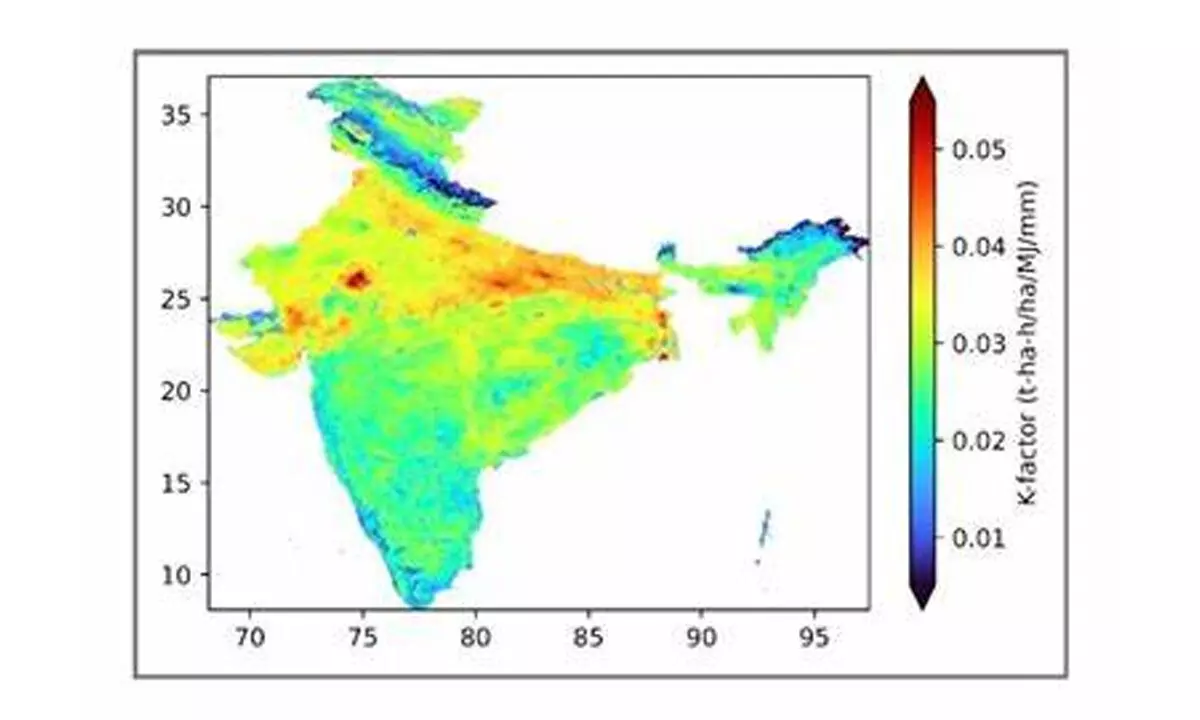Live
- Prateeksha Srivastava says she seldom meets fellow music composers Rusha, Blizza, in person
- KTR Accuses Government of Brutality Against Farmers, Calls for Immediate Action
- Manchu Manoj Attends Shooting Amid Family Controversy
- BWF World Tour Finals: Treesa-Gayatri defeat Malaysian pair to keep semis hopes alive
- MUDA case: Complainant Krishna asks Lokayukta to file new plaint on CM Siddaramaiah on ED’s report
- Airport capex in India to cross Rs 60,000 cr in fiscals 2025-2027 to handle growing traffic: Crisil
- Five-Year-Old Boy Dies After 55-Hour Rescue from Borewell in Rajasthan's Dausa
- Chaos in Parliament over Congress-George Soros link claims, BJP MP poses questions
- Bus Driver Arrested After Deadly Accident in Mumbai’s Kurla; 42 Injured
- Community lunch, a ritual to prevent drought in Adoni
Just In

Researchers at IIT Delhi have developed a national-scale mapping of soil erodibility, a first of its kind in the country, said the IIT officials on Monday.
New Delhi: Researchers at IIT Delhi have developed a national-scale mapping of soil erodibility, a first of its kind in the country, said the IIT officials on Monday.
According to the IIT Delhi, the researchers in their study have found that out of the 50 districts with the most erodible soil, 29 are in Uttar Pradesh, 13 in Bihar, three in Gujarat, two each in Haryana and Rajasthan, and one in Punjab.
This national-scale mapping of soil erodibility highlights specific areas where the soil is most prone towards erosion. The process of erosion starts when rain falls on soil or when water flow (runoff) displaces the soil particles, the official added.
Soil erodibility is the susceptibility of soil particles from becoming detached and reflects the combined effect of rainfall, infiltration, and runoff. It is one of the major factors used to estimate soil loss and reflects the effect of soil structure, texture, permeability, and organic matter content in countering soil erosion, officials at IIT added.
IIT Delhi said that till now, soil erodibility assessments have been conducted in specific regions or catchments, but a national-scale assessment of soil erodibility was required. Now, researchers at IIT Delhi have developed a national-scale mapping of soil erodibility.
Prof. Manabendra Saharia, Department of Civil Engineering, IIT Delhi. said, “This reflects the combined contribution to erosion due to rainfall, runoff, land use, land cover, deforestation, and agricultural practices. This study fills a critical gap and brings us one step closer to estimating soil loss at a national level and developing a soil erosion model.”
Saharia added, “Soil erosion is a significant trigger for land degradation and a major global geo-environmental issue. Being able to assess its causes and impacts at a high-resolution will help us develop a national soil conservation plan that can help our vital agricultural sector”.
The study by Ravi Raj (PhD Scholar), Prof. Manabendra Saharia and Prof. Sumedha Chakma from the Hydrosense Lab, Department of Civil Engineering at IIT Delhi, exploring the spatial variation of soil erodibility and its relationships with soil properties in India was published in the journal CATENA.
The IIT said that the dataset has been freely released as the Indian Soil Erodibility Dataset at a spatial resolution of 250 m.
The study estimated the national average soil erodibility factors for India as using Nomograph and EPIC models, respectively.
The researchers found histosols soil type as least susceptible to soil erosion, having the lowest average K-factor while the Xerosols soil type was observed as most susceptible to soil erosion, having the highest average K-factor corresponding to the soil classes in Indian conditions, they added.
In addition to this, the researchers conducted a comprehensive statistical analysis of the soil erodibility map to visualize its distribution over the national territory in terms of the different soil types, textures, and percentage ranges of erodibility values. The results indicated that the K-factor, estimated using the Nomograph approach, exhibited a stronger correlation with the observed K-factors retrieved from the literature, IIT Delhi said.
They further suggested that the CLOM factor, which indicates the availability of soil organic carbon content, showed a high correlation with the K-factor, specifically in the Indian region, among the erodibility indices. This study develops a comprehensive understanding of soil erodibility and its indices over India and will be an important dataset to perform soil loss estimations at a national scale, the officials added.

© 2024 Hyderabad Media House Limited/The Hans India. All rights reserved. Powered by hocalwire.com







